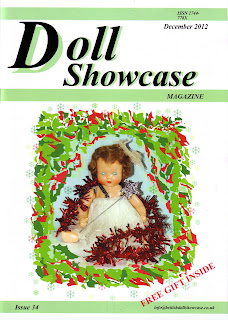MUSINGS FROM THE BOWER 24
‘So this is Christmas
And what have you done
Another year over
And a new one just begun
And what have you done
Another year over
And a new one just begun
And so this is Christmas
I hope you have fun
The near and the dear one
The old and the young’
The near and the dear one
The old and the young’
I love Christmas. When I think back to all the Christmases I’ve known, there is quite a contrast between my childhood ones and those of today. For a start, we are so much more materialistic that we were sixty or so years ago. People of my generation often say, ‘When I was a child, a tangerine wrapped in foil, a book and a handful of sweets were my Christmas gifts. And I was lucky to get those.’ It’s true there was little money about after the war, but maybe I was specially lucky, as I usually had a doll together with a tea set, doll’s cot or highchair, as well as assorted novelties, though I never had the heap of presents children get today.
I recall coming downstairs one Christmas morning – I must have been about eight – and had already unpacked the pillowcase of books, puzzles and a doll that had mysteriously appeared in my bedroom overnight. There, in the living room was a desk and chair, something I had wanted for so long. The desk was made from plywood with blue metal legs, and even had an inkwell. The chair was wood with blue metal legs. When I lifted the desk lid, there inside was a Bible, a gift from a favourite aunt. I recall being amazed that I had a desk as well as my pillowcase gifts and spent most of the day sitting at the desk and alternating reading the Bible with reading my new Beano annual!
Decorations were not as prolific in the shops as they are today, but we still made our rooms look festive, especially with paper chains which seem to be out of fashion nowadays. Sometimes we would buy narrow strips of gummed paper which were threaded through each other to make a chain – they needed to be licked to form the links – but often we would buy packets of crepe paper which we would cut into 3” wide strips. We would take strips of two different colours, such as red and green, and machine them together straight down the middle. Then we would make small cuts along the edges to form a frill. One end of the strip was drawing-pinned to the ceiling and then twisted before being pinned to the opposite corner of the ceiling. Often, the colourful crepe paper strips were then enhanced with Lametta (long narrow strips of metallic silver paper) which was thrown over them to hang down like icicles.
Other decorations included honeycomb-paper balls and bells which folded flat when not in use, and tinsel which was invariably silver and much thinner than today’s tinsel. It was also prone to tarnish. Artificial trees were used by some people, but most of us bought a real Christmas tree from the greengrocer and dressed it with glass baubles, bells made from foil milk bottle tops and large electric ‘fairy’ lights – much bigger than today’s strings of tiny bulbs. The tree was topped with a plastic fairy doll, usually bought from Woolworths. Finally, we placed the crib in position. I still have the crib that I was given when I was about eight or nine – it’s a small, plastic affair with flat figures and is very special to me.





















































